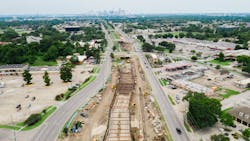Across the country, cities are taking a creative approach to stormwater management as climate change increases the number and intensity of hurricanes and other severe weather events. New Orleans, a city famously susceptible to intense weather, has developed a number of green infrastructure projects in recent years to manage urban flooding and improve resiliency.
The city, which receives around 64 inches of rain annually, has worked on projects to reduce the impact of urban flooding, including the installation of underground holding tanks, porous pavement, and rain gardens in many of its historic neighborhoods.
“[Our] approach to managing stormwater [is to] store the water where it lands, reduce the water that gets concentrated, and then also possibly divert that water so that [it flows slowly] to the pump station,” Mary Kincaid, sustainable infrastructure program manager at the City of New Orleans’ Project Delivery Unit, said.
When the amount of stormwater entering the pump station exceeds the pump’s capacity, stormwater overflows in the streets, causing flooding. In 2012, a dramatic example of the limits of pump stations as a method to reduce flooding events occurred when Hurricane Isaac brought 20.66 inches of rain in 48 hours and caused $3.11 billion in damages.
Since 2016, the city has received a combined $270 million awarded by the Federal Emergency Management Administration’s Hazard Mitigation Grant Program (FEMA HMGP) and United States Department of Housing and Urban Development (HUD) National Disaster Resilience Grants. This funding has supported the city’s first comprehensive resilience district in the Gentilly neighborhood, with projects that reduce flood risk while supporting the area’s recovery and revitalization through green infrastructure projects. Twelve projects and programs will be implemented in the area, which is bordered by Lake Pontchartrain to the north, France Road to the east, Bayou St. John to the west, and Gentilly Boulevard to the south.
These projects include efforts to slow soil subsidence and take pressure off of the city’s drainage system by retaining groundwater and capturing stormwater on the landscape during rain events. Known collectively as the Gentilly Neighborhood Resilience District, projects include bioswales, rain gardens, pervious pavement and pipe upgrades that will store up to 34.3 million gallons of stormwater and reduce flooding in other areas.
Although the city oversees the Gentilly Resilience District, flood mitigation in New Orleans is a collaborative effort between the city government and the Sewerage and Water Board of New Orleans (SWBNO), which oversees 68,000 catch basins, 1,500 miles of lateral, underground drainage pipes, 200 miles of open and underground canals, and 120 pumps housed in 24 drainage pump stations (DPS) in its stormwater holdings.
“One of the challenges with resilience projects, and what really differentiates a resilience project from a typical, more standard [green infrastructure] project, is that it achieves multiple benefits toward our resilience strategy,” Tyler Antrup, director of strategy and master planning with SWBNO, said. “So, it’s usually about flood reduction. It’s about reducing the urban heat island effect, [and] it’s about reducing disparities in equity or access.
“It requires a lot of coordination. It requires a lot of consensus around different competing goals and issues. We have to form a really strong partnership with [the city] — as we have — so that we can coordinate through the design and construction phase. And then as we near operations, we can really come to a tight agreement about who’s going to take on which portions of the ongoing operations.”
Interestingly, the city’s drainage system is bifurcated by pipe size, with the city owning and operating catch basins and drainage lines under 36 inches. The Sewerage and Water Board manages assets over 36 inches, along with pump stations and larger infrastructure.
The Mirabeau Water Garden — a centerpiece in the Gentilly District — is a testament to the working relationship between the city and SWBNO. The 25-acre space, formerly home to the Congregation of the Sisters of St. Joseph’s convent, was donated to the city by the nuns who lived there after being devastated by Hurricane Katrina and a later fire.
“[The] Water Garden includes a pump station, which would always be something that’s the Sewerage and Water Board’s jurisdiction, but it’s also a facility that is owned and being built by the city,” Antrup said.
The city designated $16.3 million in HMGP funding, along with $10 million from HUD, to create stormwater lagoons, maintenance paths, a weir pump and a pump house on the Water Garden site, but wanted to do more to use the space to foster community development.
“Hazard mitigation [funding] only allows you to [complete projects] that directly reduce stormwater flooding,” Kincaid said. “So, with the HUD grant, we [will] add some educational buildings [and] some signage so that people who visit the park can take an action on their own property to reduce stormwater flooding.”
Kincaid said the final development will feature a meditation labyrinth and demonstration vegetable garden to educate visitors on the benefits of urban gardening.
Under a Consent Decree, SWBNO managed its separate sewer system from 2014 to 2019 with $2.5 million from U.S. EPA, using a portion of the funding to develop green infrastructure throughout in the city. In areas of SWBNO’s jurisdiction where the highest neighborhoods reach 10 to 11 feet above sea level, parks and gardens have become a space to slow and store rainwater before it reaches lower areas.
“For us, green infrastructure more than anything is really about creating additional storage within the system,” Antrup said.
Creating areas in the city for water to intentionally flood, and then be held until a storm passes, is ideal. More intensive planting, such as shrubbery, tall grasses, or a bioswale, will also reduce the amount of stormwater that gets to the streets. It’s a mix of solutions, Antrup said, that will allow the city to maximize water storage and bring New Orleans into its resilient future.
“In some cases, we have large public parks or open green spaces where we’ve built storage underneath the playing fields of the parks, and that typically takes the form of a tank that goes underground,” he said. “But then, we’re also looking at taking [some of] these really large open spaces and excavating them and using grading to create these really nice open spaces that, when they’re dry, are really wonderful places for people to gather and spend time. Then when we have these large rain events, they’re able to fill up and serve a dual purpose as a stormwater storage facility.”
Storage, Kincaid said, is the most effective tool in the city’s arsenal against flooding. “We store stormwater in underground containers that eventually release to the drainage system, but we can also do storage in trees. A five-year-old live oak tree takes up 55 gallons of water a day, so trees do matter. We can store it in bioswales and rain gardens, but no matter how we do it, storage is really the most effective in terms of reducing flooding because you’re also taking a little bit of that stormwater completely out of the system and either putting it into the plant or putting it into the soil.”
In a nearly 300-year-old city like New Orleans, these large spaces are not always plentiful, so smaller storage systems that can fit in among existing infrastructure or roadways make up a sizable portion of the city’s resiliency plan.
“As part of our hazard mitigation [work], the Drainage Pump Station 01 (DPS01) project encompasses Central City, which is one of our older neighborhoods and a very heavily paved neighborhood, featuring tight spaces with houses built almost up to the public right-of-way line,” Kincaid said.
Small plastic containers the size of a shoe box will be installed under the pavement as part of the roadway structure in the area. Their small size and modularity allow the storage units to fit in and around house connections, existing water lines, fiber optic cables or other buried infrastructure.
“There’s a storage option, no matter how tight the area is,” Kincaid said.
For SWBNO’s Antrup, the next step for New Orleans is to develop a new comprehensive master plan to guide the organization’s work for the next 50 years.
“We really see this as an opportunity to begin to have a conversation with our community about what climate change means to us as residents of a city that is one of the most climate change impacted cities in the world, and start to talk about [how] we can use green infrastructure to make ourselves more resilient and thrive in the face of climate change by using nature-based solutions,” he said.
Having leveraged hazard mitigation funding to not only respond to but to prepare for future events, Kincaid says she is ready to help other cities work on funding similar projects.
“We’re happy to talk with anyone about our experiences with this program,” she said. ‘It’s been a very beneficial program. It won’t resolve all the problems, but it does allow you to have greater flexibility with [other projects].” WW








